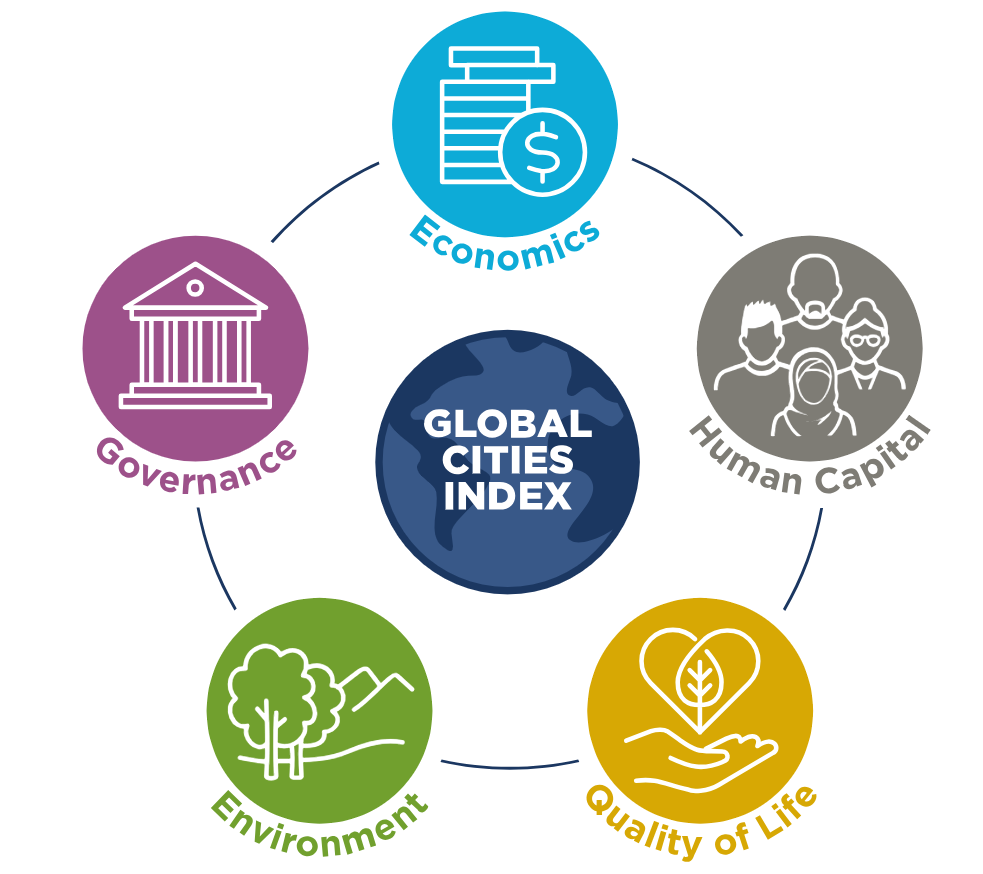Oxford Economics’ Global Cities Index reveals the top performing cities in 2025
The global economy is in the midst of a period of acute uncertainty as trade tensions and deglobalisation are causing considerable headwinds to economic growth worldwide. In the face of uncertainty, the world’s leading cities have historically demonstrated resilience, making them best placed to navigate the current challenges.
Evaluating the opportunities and challenges cities are grappling with is made more complicated by the inherent structural differences of urban areas located in different regions around the world. Our Global Cities Index is designed to address this challenge. Covering the 1,000 largest cities in the world, the index evaluates urban economies on a wide range of metrics covering five broad categories: Economics, Human Capital, Quality of Life, Environment, and Governance—providing a nuanced understanding of each city’s strengths and weaknesses.

The top 10 cities of 2025
The 2025 update of the Global Cities Index reflects the latest assessment of the structural advantages cities possess, the opportunities available, and the challenges they need to tackle.
While there are many small movements in the rankings compared to last year, overall, they have remained stable, suggesting that cities are staying resilient in the face of a myriad of challenges. Eight of the top 10 cities are the same as last year, and New York and London remain in the top spots for the second year running.
Both cities perform best in the Economics and Human Capital categories, emphasising their roles as global hubs for finance, business, and education. New York has the largest metro economy in the world, and London has the fourth largest. Similarly, both cities have among the most universities and corporate headquarter offices. As highlighted by their scores, the two powerhouses on either side of the Atlantic are very much neck and neck at the top of the index.
Paris, San Jose, and Seattle round out the top five. All three have top Economics scores, Paris due to the sheer size of its economy, and tech hubs San Jose and Seattle due to their high levels of GDP per person. While these three cities score slightly lower than New York and London on the Human Capital front, they outperform the top two cities in terms of Quality of Life. Paris benefits from its plethora of world-renowned cultural sites and high life expectancy, while residents of San Jose and Seattle have among the highest average incomes in the world.
Two new cities enter the top 10 this year: Sydney and Boston. Sydney takes the seventh spot due to an improvement in its Quality of Life and Environment scores, while Boston saw an increase in its Economics score. Los Angeles (#11) and Zurich (#16) fell out of the top 10 this year—in part due to declines in their Human Capital scores—but they are still among the strongest performing cities in the world. A detailed profile for each of the top 50 cities in this year’s index analysing their strengths and weaknesses can be found in the report.
Changing economic outlooks lead to movements in the rankings
A broader theme evident in the movements in this year’s rankings is the role of changing economic outlooks. In some cities, a more resilient GDP growth forecast in the face of global headwinds has boosted rankings. For example, several cities in India, Indonesia, and the UK have improved their positions this year, whereas Japanese, Canadian, and Brazilian cities mostly declined. Cities in the US, China, Australia, and continental Europe experienced a mix of outcomes.
At the same time, it is important not to extrapolate too much from only two years of rankings. Some cities are likely to reverse their rises/falls next year, while others will continue on their current path. It will take a few years to be able to determine which movements are longer-term trends, and which are single-year blips.
In 2024, the 1,000 largest cities in the world were home to a third of the global population but produced nearly 60% of global GDP. As the world economy navigates the current period of uncertainty, the importance of cities as economic engines and human capital hubs will only continue to grow. Tools like the Global Cities Index can help identify the opportunities and challenges facing different cities around the world, and which ones are rising to the occasion.
The Oxford Economics Global Cities Index ranks the largest 1,000 cities in the world based on five categories: Economics, Human Capital, Quality of Life, Environment and Governance. Underpinned by Oxford Economics’ Global Cities Service, the index provides a consistent framework for assessing the strengths and weaknesses of urban economies across a total of 27 indicators. To our knowledge, this is the largest and most detailed cities index in the industry. To download the full report, please fill out the form below.
Tags:
Related Reports

City archetypes: A new way to classify cities in the Global Cities Index
Oxford Economics defined the archetypes using a range of metrics from all five categories of the Global Cities Index, with each archetype focusing on a different set of common traits.
Find Out More
Oxford Economics Launches Global Cities Index 2025
Oxford Economics is proud to launch the 2025 update of the Global Cities Index, which offers an evaluation of the world's 1,000 largest urban economies.
Find Out More
All US metros worse off from recent tariff announcements
President Trump's recent tariff announcements, and the global response, have meant a fast-changing policy landscape with significant effects on our global, national, and subnational outlook.
Find Out More
Trade policy uncertainty weakens the short-term outlook for European cities
Europe's major city economies, on average, are fairly well-insulated. However, within this group there are still some notable variations.
Find Out More
